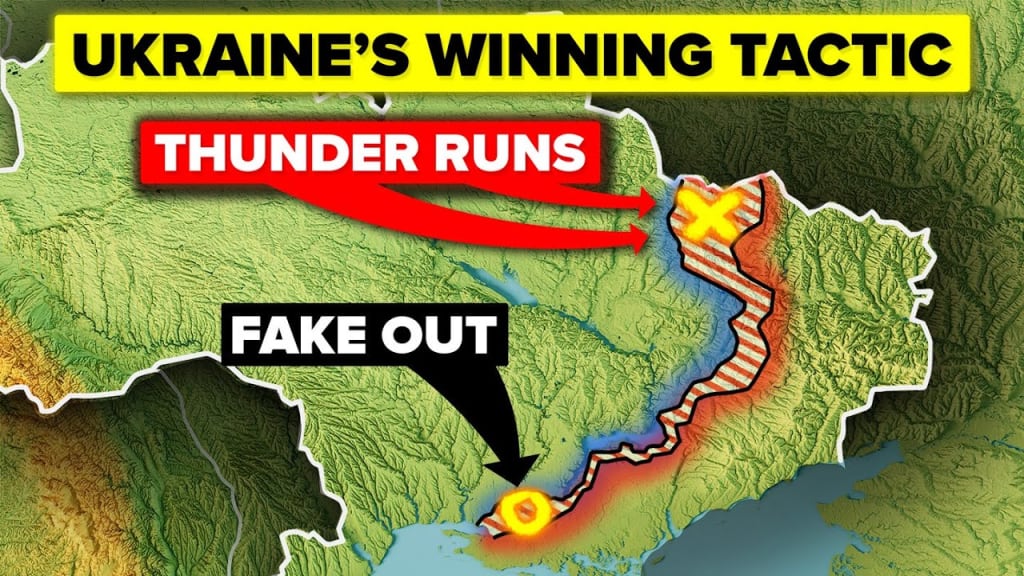How did Ukraine's Thunder Run effectively take the Russian military by surprise?
The Ukrainians carried out one of the finest military deception efforts in recent history in September. While the world was paying attention to the continuing Kherson offensive, which began in mid-August, the Ukrainian military was discreetly preparing for its true onslaught in the east. The Ukrainian army started its Kharkiv onslaught in the late hours of September 6th. By mid-October, the attack had liberated nearly 12,000 square kilometers of terrain. But how did the Ukrainians hand Russia's military its biggest battlefield loss since World War II? Thunder Runs is the concise answer to that question.

The Thunder Runs ❌⚡😎⚡❌
The Ukrainians carried out one of the finest military deception efforts in recent history in September. While the world was paying attention to the continuing Kherson offensive, which began in mid-August, the Ukrainian military was discreetly preparing for its true onslaught in the east. The Ukrainian army started its Kharkiv onslaught in the late hours of September 6th. By mid-October, the attack had liberated nearly 12,000 square kilometers of terrain. But how did the Ukrainians hand Russia's military its biggest battlefield loss since World War II? Thunder Runs is the concise answer to that question. ❌⚡😎⚡❌
- One of the best military deception campaigns in recent memory was carried out by the Ukrainians in September. The Ukrainian military was covertly preparing for its true offensive in the east while the world was focused on the ongoing Kherson offensive, which began in mid-August. The Ukrainian army began its Kharkiv offensive late that evening, on September 6. By the middle of October, roughly 12,000 square kilometers of territory had been liberated as a result of that offensive. That is roughly the size of the US state of Connecticut, to put it into perspective. But how did the Ukrainians hand the Russian military its worst battlefield defeat since World War Two? The shortest answer is that thunder runs.
- Returning to the US experience in Vietnam is necessary to comprehend what a "Thunder Run" is. The NVA and VC soldiers learned during that battle that they were outnumbered by armored vehicles. These Communist soldiers had a lot of mines despite having no armored support. It was well known that there were many mines along the main thoroughfares and roads leading from major population centers. US troops were forced to constantly stop their convoys so that they could carefully scan the ground with metal detectors due to the frequent threat of mines. Convoys would have to stop for hours at a time, which would cause major traffic jams. As a result, Communist soldiers frequently ambushed American convoys as they stood still on the highway while they awaited clearance from the engineers to move on.
- American commanders quickly realized that their outdated methods of operation were costing them the tactical and, eventually, strategic initiative. Far-flung outposts would find it much harder to resupply, reinforce, and communicate with larger formations if US convoys could not reliably reach their destinations. The American military leaders came up with a brilliant solution to this dilemma: simply run the mines over. The tactic was straightforward due to the M48 Patton tank's ease of resistance to the anti-personnel mines that were a common sight on Vietnam's roads. Convoys were led by M48 tanks, which would lead the way and clear every mine in their path.
- Another tank could step in and continue moving if a tank lost a track or suffered minor damage. The American military made certain it could effectively navigate Vietnam's highways by using this straightforward but brutally effective tactic. Fast-forward nearly 40 years, and the United States is currently entangled in the war on terror. Under the direction of President Bush, the United States invaded Iraq as part of that conflict on the false pretext that Saddam Hussein was keeping WMD. While we won't get into the political discussion about the legitimacy of the US invasion, it is obvious that it was a work of American military genius, in large part because of the contribution of General William Wallace.
- General Wallace, a Vietnam veteran and prude history student, assumed command of the V Corps just before the 911 attacks. He quickly absorbed the 2002 publication of the US study of mounted warfare in Vietnam and revived the Thunder Run as a workable strategy with some modifications. It was the ideal strategy for seizing power because it placed a strong emphasis on quickness and violence of action. President Bush had been concerned about the significant casualties that would result from a protracted battle for Baghdad before the invasion of Iraq began. Bush was terrified of a costly city battle due to the US's experience in Vietnam and the Russian experience in Chechnya trying to take Grozny.
- Fortunately for him, General Wallace approached Central Command with such a brilliant idea that it was eventually briefed to the President, who personally approved it. The strategy was fairly straightforward. In order to isolate Baghdad, it first built an inner and outer cordon around it. At that point, 55 sectors were created within the city. V Corps would establish an armored convoy of tanks and armored fighting vehicles once it was established. Then, as it entered the city at full speed, this convoy would attack predetermined targets inside these sectors and gather real-time intelligence on Iraqi positions and defense preparations. The convoy would only pause during the Thunder Run to remove crews from any wrecked vehicles.
- The Thunder Run had some significant advantages, even though it appeared to be an insane suicide mission. Creating chaos in the enemy's back areas was the main advantage. The fact that an American armored column was inside the city center would cause confusion and panic among the Iraqis because there was no way to tell how far into the city the Americans had advanced. This was because the US bombing campaign had already weakened Iraqi command and control. The second advantage was that it functioned as forceful reconnaissance. Human intelligence was still lacking, despite the US's use of cutting-edge drones, aircraft, and surveillance systems.
- American troops were able to provide accurate reports on enemy strength, weapon locations, morale, and other crucial war effort data by positioning themselves close to the city. The US commanders intended the operation to be a psychological operation against the Iraqi people and government, which was the third advantage. General Wallace had television broadcasts playing that discussed the war as it was being waged by the Saddam regime, both before and during the Thunder Runs. He could disprove the regime's assertions about the war and, ideally, weaken the Iraqis' resolve to forgo a pricey house-to-house conflict by infiltrating deep into Baghdad. Amazingly, the plan performed even better than anticipated.
- The second Thunder Run entered and took control of the Presidential Palace after the first one had almost reached it. The organized resistance quickly disintegrated as a result of the Iraqi soldiers' complete shock. In fact, the Thunder Run strategy was directly credited with cutting the conventional war's duration by at least a few weeks and ultimately saving the lives of hundreds, if not thousands, of Allied soldiers.
- The Ukrainian government is in a similar predicament during the war in Ukraine, which is almost another twenty years away. The city of Kharkiv has been encircled on three sides ever since the invasion started. The government wanted to end the siege and continue moving eastward in order to eventually retake the occupied territories of Luhansk and Donetsk, despite the resistance of Kharkiv's defenders. The lack of troops, however, was a significant issue for the Ukrainian government.
satiretransportationreviewquotespresidentpoliticspoliticianslisthistoryfeaturefact or fictioneducationdefensecontroversiesactivism
1
Share






Comments
There are no comments for this story
Be the first to respond and start the conversation.